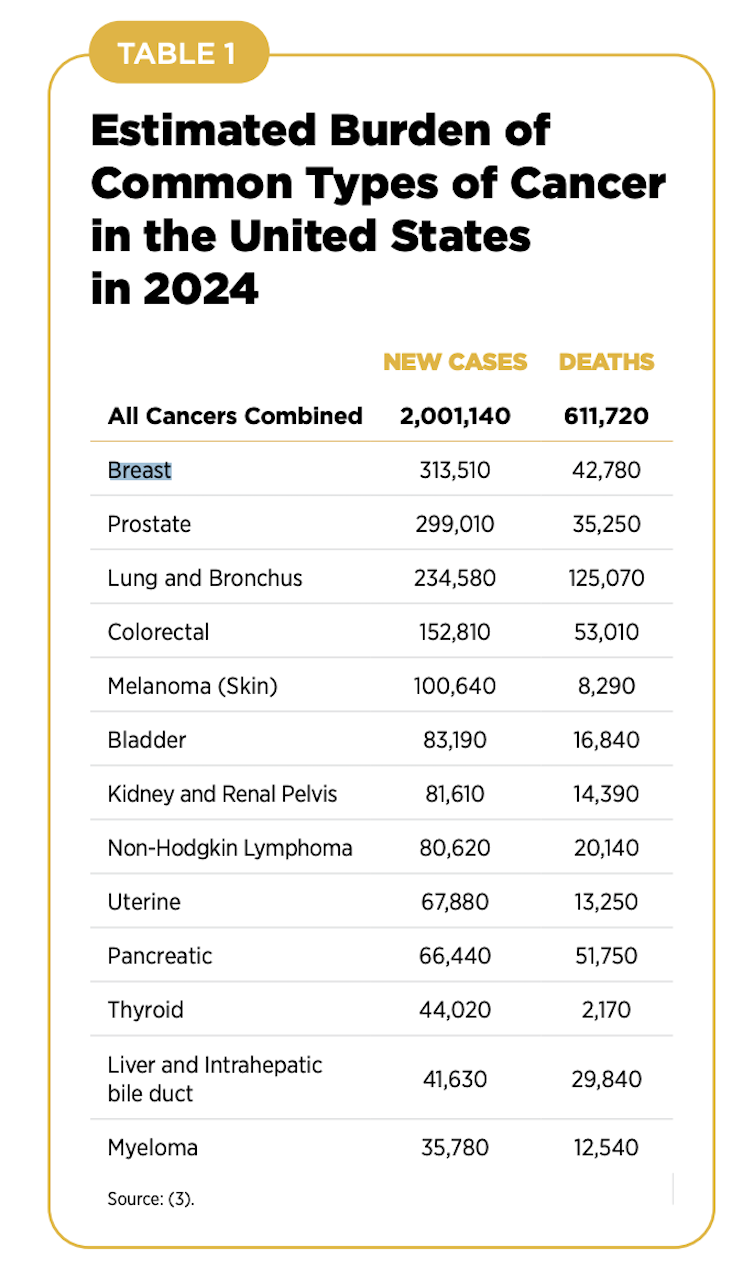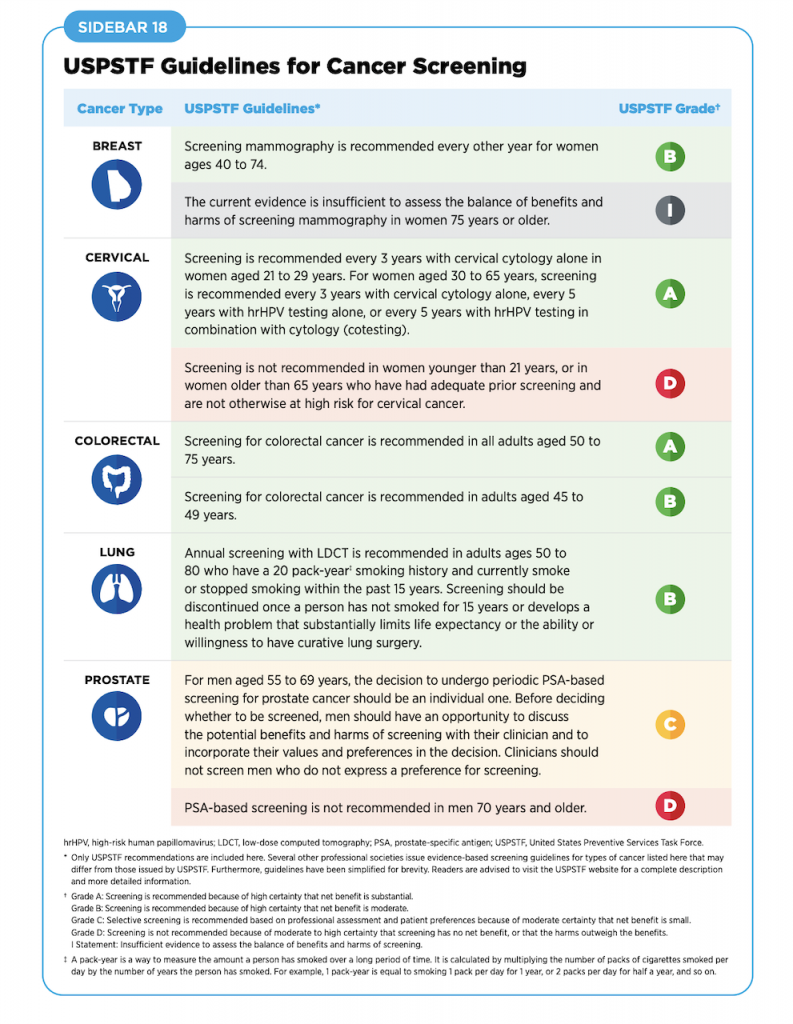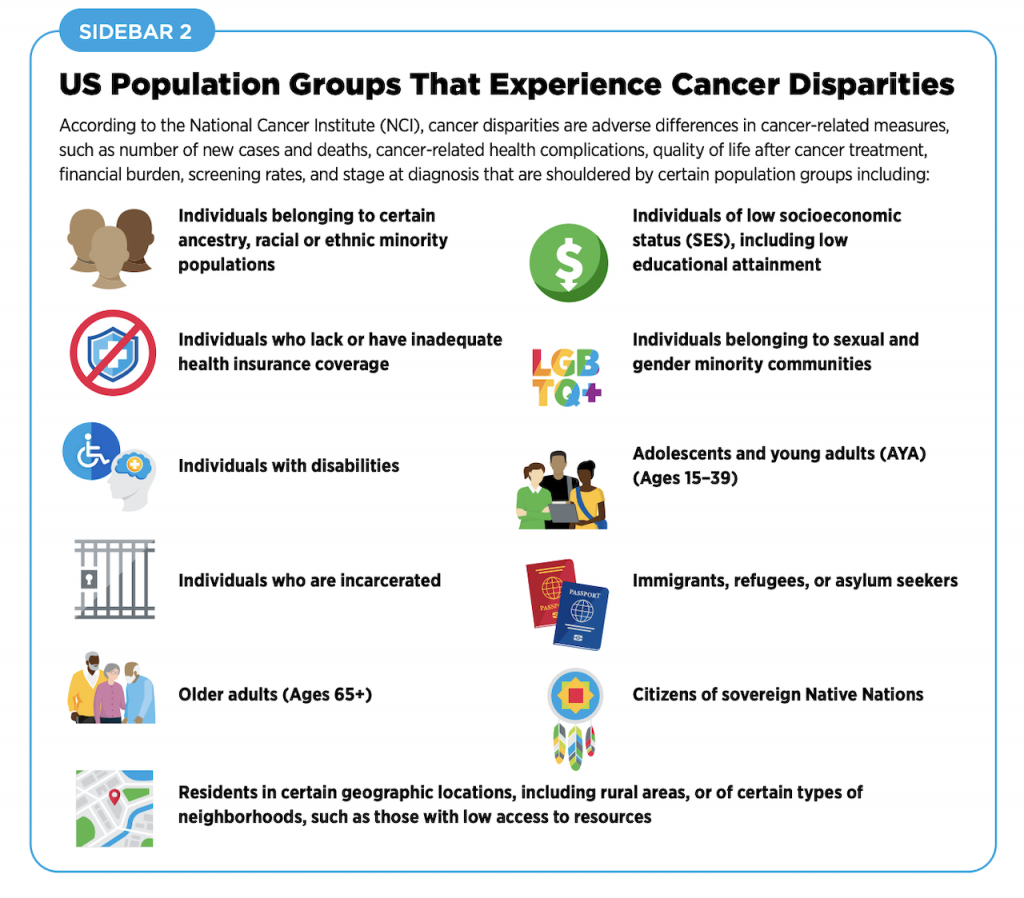Looking at the AACR's Annual Cancer Progress Report
- The 2024 American Association for Cancer Research (AACR) Cancer Progress Report has revealed that breast and prostate cancer incidence has surpassed lung cancer in the United States.
- Meanwhile, the decreased lung cancer rates are attributable to a reduction in smoking rates, in addition to treatment advances and early detection methods.
- With this knowledge, it’s important to understand the recommended screening guidelines for these types of cancers: The medical community has a consensus that women between 45 and 54 have annual mammograms. However, an independent panel of experts called the U.S. Preventive Services Task Force (USPSTF) is saying that women should start getting mammograms every other year at the age of 40, suggesting that this lowered the age for breast cancer screening could save 19% more lives.
- For women aged 55 and older, the American Cancer Society recommends getting a mammogram every other year. However, women in this age group who want added reassurance can still get annual mammograms.
- The United States Preventive Services Task Force recommends men at average risk between the ages of 55-69 years old should talk with their doctor about the pros and cons of prostate cancer screening.
The annual report offers updated statistics for incidence, mortality and survivorship rates, and information on the most recent research and discussions continued challenges in cancer care.
Read More- The overall cancer death rate in the U.S. has been on a steady decline since the 1990s, and more than 4.1 million cancer deaths avoided between 1991 and 2021.
- Researchers predict that there will be 26 million survivors in the U.S. by 2040.
- The decreased lung cancer rates are attributable to a reduction in smoking rates, in addition to treatment advances and early detection methods.
- Although breast cancer death rates have seen a 42 percent reduction between 1989 and 2021, breast cancer is at the top of the list at 313,510, when it comes to the estimated burden of common type of cancer in the U.S.
- Followed by breast cancer incidence, the estimated number of prostate cancer cases is 299,010, followed by lung and bronchitis cancers at 234,580.
- As of January 1, 2022, there are more than 18 million cancer survivors living in the U.S. experience evident inequalities affecting the cancer statistics, which are affected by structural and social factors.
- The age adjusted overall cancer death rate has declined by 33 percent between 1991 and 2001.
- Among children (14 years and younger) and adolescents (15 to 19 years) across the U.S., the overall cancer death rates have declined by 70 percent and 63 percent. The overall cancer death rate for children and adolescents in the U.S. declined by 24 percent over the past 20 years.
- Despite all of the good news and recent achievements, it’s estimated that more than two million new cases of cancer will be diagnosed in the United States in 2024.
- Another concern is that breast, colorectal, gastric, and certain blood cancers in adults younger than 50 are also on the rise, and the reasons why are not clear.

Helpful Information About Breast and Prostate Cancer Screenings
With breast and prostate cancerdiagnoses being at the top of the incidence list for 2024, we think it’s imperative to be aware of breast cancer screening guidelines.The medical community has a consensus that women between 45 and 54 have annual mammograms. However, an independent panel of experts called the U.S. Preventive Services Task Force (USPSTF) is saying that women should start getting mammograms every other year at the age of 40, suggesting that this lowered the age for breast cancer screening could save 19% more lives.
For women aged 55 and older, the American Cancer Society recommends getting a mammogram every other year. However, women in this age group who want added reassurance can still get annual mammograms.
Women with a strong family history of breast cancer, have dense breasts, have a genetic mutation known to increase the risk of breast cancer, such as a BRCA gene mutation, or a medical history, including chest radiation therapy before age 30, are considered at higher risk for breast cancer.

Experiencing menstruation at an early age (before 12) or having dense breasts can also put you into a high-risk category. If you are at a higher risk for developing breast cancer, you should begin screening earlier.
Breast density is determined through mammograms. However, women with dense breasts are at a higher risk for developing breast cancer because dense breast tissue can mask potential cancer during screening. 3D mammograms, breast ultrasound, breast MRI, and molecular breast imaging are options for women with dense breasts for a more precise screening. It is important to ask your doctor about your breast density and cancer risk.
Meanwhile, prostate cancer is the most common type of cancer in males, typically affecting 1 in 8 during their lifetime.
Since his cancer journey, Roker has become a strong voice in the cancer community, pushing men to get in for screenings, especially Black men, who have a higher death rate from the disease.

Staggeringly Higher Prostate Cancer Rates for Black & Latino Men
According to research published in the World Journal of Men’s Health, in the U.S., cases of prostate cancer among Black men are “60 percent higher” than white men.
Prostate cancer does not always behave the same in every man it impacts. The cancer can be considered “low-risk” and can be slow-growing, and treatment might not be necessary.
In other men, the cancer may grow faster or more aggressively, requiring more immediate treatment. Because of this, there is some debate about screening.
The United States Preventive Services Task Force recommends men at average risk between the ages of 55-69 years old should talk with their doctor about the pros and cons of prostate cancer screening.
The American Cancer Society recommends that men at age 50 who are at average risk should begin screening. Men who are at high risk of prostate cancer, including the Black community, should begin screening at age 40, while men with a close relative diagnosed with prostate cancer should consider annual screenings in their 30s.
Black Americans Need to Prioritize Cancer Screenings, Says Leading Radiation Oncologist
Most doctors agree that men over the age of 70 do not need screening.
SurvivorNet experts suggested that men consider factors like their family history, genes, and age when deciding whether and when to screen.
Expert Resources On Early Detection & Cancer Screenings
- 6 Common Excuses for Skipping a Mammogram That You Need to Stop Using!
- How to Avoid False Positive Cancer Results in Women With Dense Breasts: Ultrasounds Used in Addition To Mammograms
- Breast Cancer: Introduction to Prevention & Screening
- The Mammogram Debate: Should Women Start Breast Cancer Screening at 30?
- Mammograms Are Still the Best Tool for Detecting Breast Cancer — A Warning About Thermography
- I Have Dense Breasts. Do I Need a 3D Mammogram?
Resources For Handling a Diagnosis
Receiving a cancer diagnosis can be an earth shattering experience, but it’s important that you know resources are always available to you.
Whether it’s a support system, prioritizing your mental health, or getting a second opinion, you and your doctor can map out the best way to handle this diagnosis and take it on together.
Find a Support System
Whether it’s a family member, friend, or support group of fellow cancer patients, support can come in a number of different ways. Having people surround you to help you during this difficult time is often a great way to help motivate you to push through treatment, and also helps your mindset.
Many cancer survivors have said that attending support groups helped them tremendously, as connecting with others who have gone through a similar experience made them feel less alone in their battle. Of course, support groups are not always for everyone, so it’s important to recognize the help you need and not be afraid to ask for it.
Prioritize Your Mental Health
Coming to terms with a cancer diagnosis can be difficult, and it can be hard to focus on anything other than treatment. However, studies have shown that a positive mindset can make a huge difference in the process, and is actually linked to successful treatment outcomes.
In order to prioritize your mindset, consider taking some time during your day to do things you enjoy, no matter how big or small.
Get a Second Opinion
While navigating treatment options, it’s never too early or too late to advocate for yourself or ask questions. Sometimes, getting a second opinion can be helpful in order to learn all about your options and talk to specialists who are experts in the field. This way you can have all the information and be able to figure out what you feel most comfortable with and which one you believe is the best option for you.
Related: Second (& Third) Opinions Matter When Deciding Between Surgery or Radiation
“If I had any advice for you following a cancer diagnosis, it would be, first, to seek out multiple opinions as to the best care,” Dr. Steven Rosenberg, National Cancer Institute Chief of Surgery, told SurvivorNet in a previous interview. “Because finding a doctor who is up to the latest of information is important.”
Contributing: SurvivorNet Staff
Learn more about SurvivorNet's rigorous medical review process.

